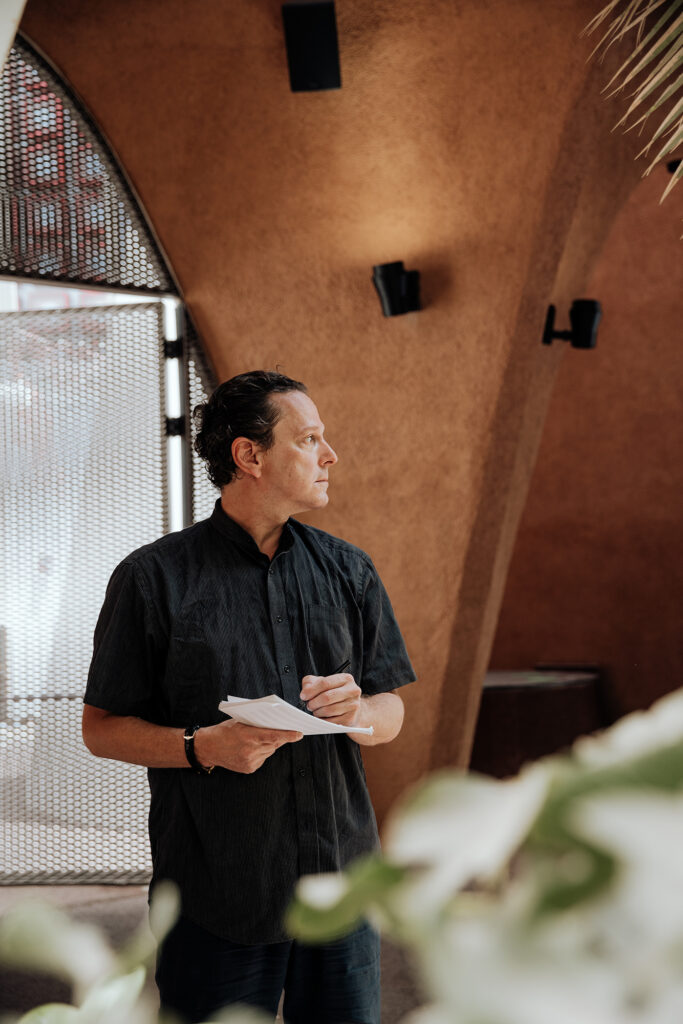RUPERT HUBER
Composer, Music Artist, Musician. Born 1967.
Based in Vienna, Austria, works internationally
Music by Rupert Huber is organized structures, sounds and tones for multiple known and unknown real and electronic spaces: Dimensional Music.
The group TOSCA – Richard Dorfmeister and Rupert Huber – has released 14 albums over the last 20 years. TOSCA has performed live with worldwide success at events such as the Coachella Festival and has won Austria’s Amadeus Music Award.
Rupert Huber´s spatial and installation work Turmgesang, Stadtmusik, Erinnerungswellen focuses on the thematic of the communication possibilities within a given space, the people there and the music of the very site itself.
His music integrates the sonification of given data such as airport soundscapes or building bridges and includes telematic performances, events and concerts near the distance 2 as well as combined live/radio/webprojects darb-i fetih
Huber’s written music (primarily for piano) explores the architecture of sound by describing a process and a space. He connects this approach of generating scores to his technique of creating objects (paintings, sculptures), distilling the essence of written music into tangible form. teardrops and 4.1
His music activities range from commissioned compositions (Wiener Festwochen, Centre Pompidou, Ars Electronica Festival) to film soundtracks (Food Design, Freud’s Lost Neighbors: Berggasse 19), TV (C.S.I. Miami, Sex and the City), radio (ORF, Deutschlandradio) and beyond.
He has been collaborating with AGF, Chris Eckman, Sam Auinger, Alvin Curran, Robert Adrian x, Horst Hörtner, Garbiel Orozco, among many others.
Rupert Huber studied composition in Vienna. He is an alumnus of the DAAD Artists-in-Berlin residency (1997), was a member of the jury of the Prix Ars Electronica (2007, 2009) and nominated for the World Technology Award in 2010.


THEORY
My music is space. It projects a space and cloaks an existing “real” space.
This is how it is with all my music. The piano pieces (the pianist in the concert space), the recording medium albums (the electronically stored music is conceived so that it can cloak or line any possible space or create it new – from large festival venues to iPhone headphones), the sound installations (people or data in a space recreate the space in the moment anew), radio pieces (similar to recording media but unpredictable for the listener, unique.
In 1992 I defined my theory of a composition technique of music projection in known or unknown spaces of a known or unknown number. I have followed, applied and refined it since then. This technique allows one to conceive of a piece of music projected in multiple dimensions during its inception. The possible projection in known or unknown spaces of a known or unknown number in known or unknown listening situations for a known or unknown number of listeners is part of the composition process. The notation, traditionally written like a book, is extended to a spatial dimension. The notation becomes three dimensional, the notion becomes structural, object-like.
My music is space. The notation describes this space.
It was a logical step to form the space-describing parameter into an object, be it as the essence of a sound space on canvas or a light object that in the moment (for the notationally relevant frequencies) is brought to light up. In interactive sound installations, the room itself is often the music score that is played by the visitors in the room.
The poetic moment of a spatial notation has two significant components:
- The often multilayered and complex projects become thereby a kind of quintessence or a mathematical formula, structurally delineated. Thus the notation wins back a lyrical element that has been increasingly lost since the Middle Ages.
- Music is an ever and again dying medium. Sound comes into being and dies away. Birth and death define a sound or tone. Different perhaps to stone sculpture, music is intrinsically dead after it has been heard. (In music we use the more gentle term “faded away”).
A music score object is an object in space that remains in existence after the music has faded away. Through viewing the piece alone, the music is recreated in the mind of the observer. For another rendition, the form and poetry of the object is an inspiration or a concept for a conducting the music.